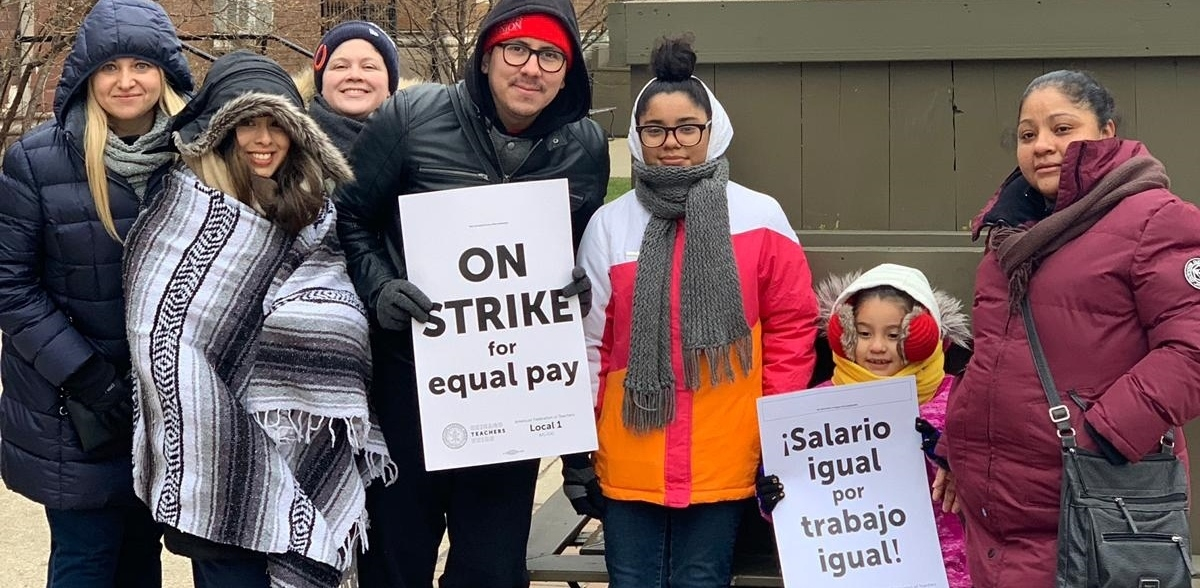Chicago Teachers Win First Charter Strike in History

Strikers want to “put a check on privatization and the idea that schools are a business,” said Joanna Wax Trost, a seventh-grade English-language teacher at Acero’s Marquez Elementary School. Photo: Hilary Naffziger
This article, originally published on December 4 as the strike began, has since been updated. --Editors.
Chicago teachers are leading the way again. They have declared victory in the first charter school strike in U.S. history.
The four-day strike included 550 teachers and paraprofessionals who work at all 15 Chicago charter schools in the Acero charter chain.
It ended December 9 with an agreement that includes smaller class sizes and salary increases that will align charter teachers with their counterparts in the Chicago Public Schools. The union hopes to schedule a ratification vote before the end of the year.
The strikers wanted to “put a check on privatization and the idea that schools are a business,” said Joanna Wax Trost, a seventh-grade English-language teacher at Acero’s Marquez Elementary School.
“What we are fighting for is bigger than the short term,” she said during the strike. “We could potentially let the people who want to privatize and the charter proponents know that there is a potent force to stand against you and protect the kids.”
Acero teachers belong to the United Educators for Justice—a chapter of the Chicago Teachers Union, which also represents the city’s public school teachers.
CTU’s 2012 strike sparked a resurgence in education unions across the country. Evidently it also inspired organizing closer to home.
EQUAL PAY, SANCTUARY SCHOOLS
Teachers at charters work longer hours than their colleagues in the Chicago Public Schools, but are paid on average $13,000 less. The result is teacher churn.
The strikers won wages equal to those of their Chicago public school counterparts. That’s a huge victory, according to bargaining team member Hilary Naffziger, a seventh-grade teacher at Acero’s Carlos Fuentes Elementary School.
Naffziger said the new competitive salaries will help retain teachers. In her building, only two teachers have been there for the full 10 years the school has been around.
The strikers also won a shorter school day with more prep time, and a shorter school year.
In a charter network where 90 percent of the students are Latino, strikers won an agreement to designate all its schools as “sanctuary schools,” off-limits to immigration police.
Among the strikers were paraprofessionals, who help provide extra attention for students who need it, especially those with disabilities. Across the country, paraprofessionals make up a second tier, paid far less than the teachers they work alongside.
For the first time, Acero paras have won a salary schedule. They also won increased compensation, paid time off, and opportunities to advance in their careers and become teachers themselves.
SECOND TIME’S THE CHARM

SUPPORT LABOR NOTES
BECOME A MONTHLY DONOR
Give $10 a month or more and get our "Fight the Boss, Build the Union" T-shirt.
Acero used to be called the UNO charter school network. It was started by a now-disgraced Rahm Emanuel ally and union critic, Juan Rangel. It rebranded after a split with the United Neighborhood Organization.
UNO teachers organized in 2014 with the Chicago Alliance of Charter Teachers and Staff, an AFT affiliate. ChiACTS became a division of CTU this year, after members of both unions voted to unite.
Teachers at the chain came close to striking in 2016, but the union was able to reach a last-minute settlement.
Still, that near-strike experience made members more comfortable voting to authorize a strike this time, Wax Trost said.
PARENTS GET IT
Charter teachers were joined on the picket line by other CTU members, as well as parent supporters. ChiACTS President Chris Baehrend said parents supported the strike because they know the charter operators have the money to do better—the funds are just being diverted to management.
Acero CEO Richard Rodriguez, who oversees the education of 8,000 students, is paid more than the CEO of Chicago Public Schools, a district with 350,000 students.
Baehrend estimates that up to one-third of per-pupil funding is siphoned off by the charter industry’s layers of management oversight, rather than meeting classroom needs.
A recent audit showed that the Acero system has $10 million more in reserves than it had a year ago and is pulling in 29 percent more revenue.
“We all know that charter schools are run like a business,” said Daniria Dukes, a paraprofessional and bargaining team member. “It is about the dollar signs.”
To support the striking teachers, parents started a Facebook page. They’ve been organizing meetings, both with and without educators, to spread the word.
“There is a lot of anger in the parent groups’” said Wax Trost. “A lot of parents have seen a decline in the services provided for their children, seen cuts in programs and services [as well as] class size going up.”
THE WHOLE INDUSTRY
This may be the first charter school strike in the country, but given the industry’s problems—and the fact that teachers and staff are finally getting organized—it won’t be the last.
ChiACTS, which represents members in 34 charter schools in Chicago, has lined up contract expiration dates for 33 of those schools—all but one—in what Baehrend says is the beginning of a wave of actions to hold the charter industry accountable to students and parents.
Members in another unionized Chicago charter network have voted to authorize a strike but have not yet set a strike date.
Because of this industry-wide approach, “we see that this is not just our struggle—this is universal,” said Naffziger. “It is really uniting us and helping to build relationships with others teachers.”





